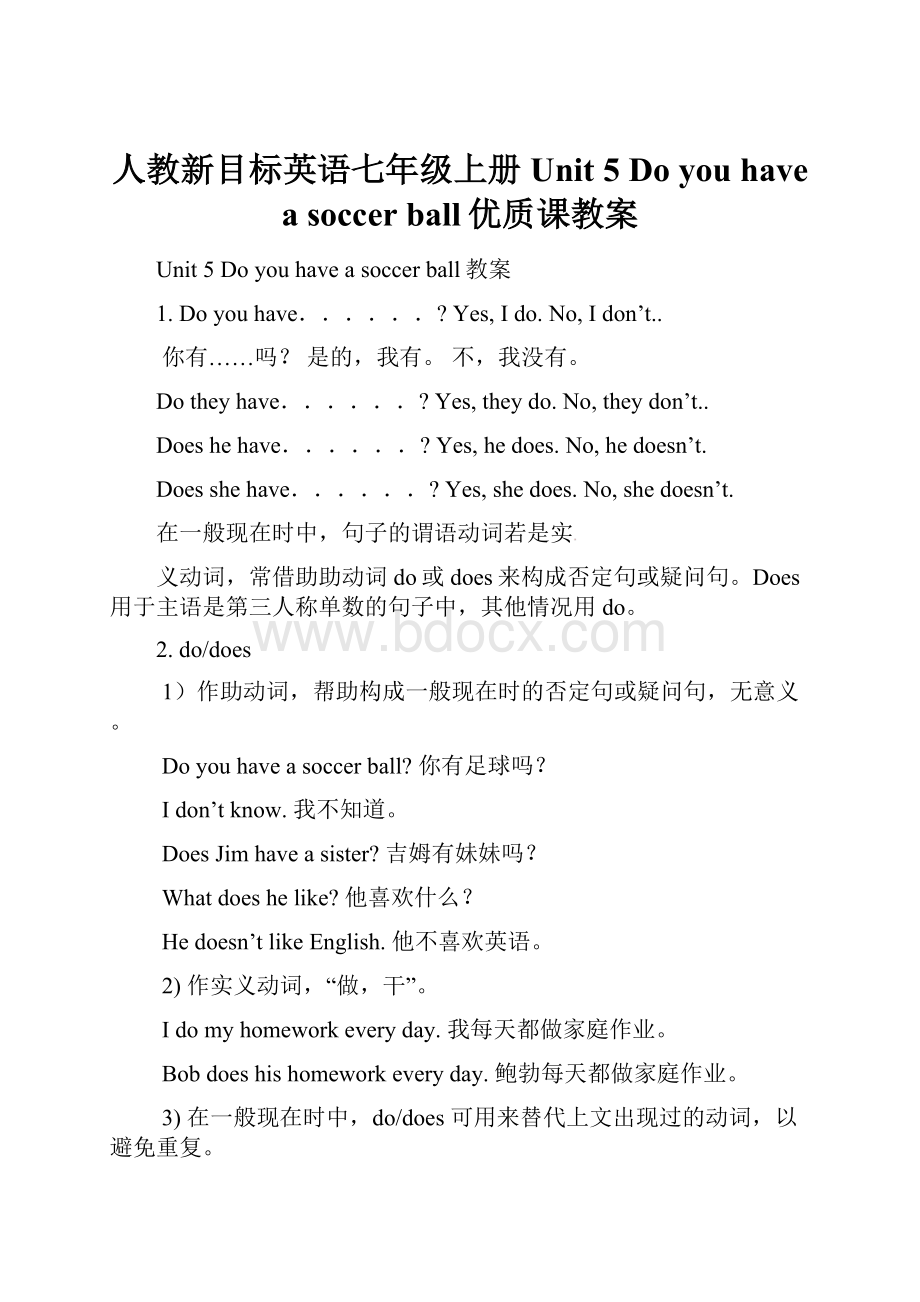人教新目标英语七年级上册Unit 5 Do you have a soccer ball优质课教案.docx
《人教新目标英语七年级上册Unit 5 Do you have a soccer ball优质课教案.docx》由会员分享,可在线阅读,更多相关《人教新目标英语七年级上册Unit 5 Do you have a soccer ball优质课教案.docx(10页珍藏版)》请在冰豆网上搜索。

人教新目标英语七年级上册Unit5Doyouhaveasoccerball优质课教案
Unit5Doyouhaveasoccerball教案
1.Doyouhave......?
Yes,Ido.No,Idon’t..
你有……吗?
是的,我有。
不,我没有。
Dotheyhave......?
Yes,theydo.No,theydon’t..
Doeshehave......?
Yes,hedoes.No,hedoesn’t.
Doesshehave......?
Yes,shedoes.No,shedoesn’t.
在一般现在时中,句子的谓语动词若是实
义动词,常借助助动词do或does来构成否定句或疑问句。
Does用于主语是第三人称单数的句子中,其他情况用do。
2.do/does
1)作助动词,帮助构成一般现在时的否定句或疑问句,无意义。
Doyouhaveasoccerball?
你有足球吗?
Idon’tknow.我不知道。
DoesJimhaveasister?
吉姆有妹妹吗?
Whatdoeshelike?
他喜欢什么?
Hedoesn’tlikeEnglish.他不喜欢英语。
2)作实义动词,“做,干”。
Idomyhomeworkeveryday.我每天都做家庭作业。
Bobdoeshishomeworkeveryday.鲍勃每天都做家庭作业。
3)在一般现在时中,do/does可用来替代上文出现过的动词,以避免重复。
Doyouhaveasoccerball?
你有足球吗?
Yes,Ido.是的,我有。
(do代have)
Doesshehaveaneraser?
Yes,shedoes.
Idon’thaveasoccerball,butmybrotherAlandoes.
我没有足球,但我的哥哥艾伦有。
3.Let’sdosth.“(让)我们做某事吧。
”表示建议。
(let’s=letus)
肯定回答一般用Thatsoundsgood.(那听起来很好)/OK.好的/Allright.好的/Great.好极了/Goodidea.好主意
否定回答一般用sorry,I...
1)让我们上学去吧。
好的。
2)我们打乒乓球吧。
对不起,我有许多家庭作业要做。
4.letsb.dosth.让某人作某事
1)让他踢足球。
2)让海伦回家吧
5.We’relate!
我们迟到了!
belatefor….……迟到Don’tbelateforschool.不要上学迟到。
6.play+球类名词:
打/踢……球(注意:
球类运动不用冠词)
playping-pong/basketball/volleyball/tennis/soccer
7.sound
1)连系动词,“听起来”,后接形容词作表语。
Thatstorysoundsveryinteresting.那故事听起来很有趣。
2)名词“声音”(泛指自然界中的各种声音)。
Thesoundistooloud.声音太大了。
8.Weplayitatschoolwithourfriends.我们和我们的朋友在学校踢。
1)atschool在学校
2)with“和;与;跟……在一起”
9.It’seasyforme.这对我来说挺容易的。
for的用法
1)供……用,给……的
Isthisappleforme?
这个苹果是给我的吗?
Hereisaletterforyourmother.这儿有你妈妈的一封信。
2)作……用(表用途)
Doyouneedbagsforsports?
你需要运动包吗?
Ineedacupformilk.我需要一个装牛奶的杯子。
3)就……而言,对于……来说
Forlunch,Ilikehamburgersandsalad.午饭我喜欢汉堡和沙拉。
Forgirls,wehaveT-s
hirtsinallcolors.女孩子们可以买到各种颜色的T恤衫。
4)以……的价格(表交换、价格)
Youcanbuysocksforonly5dollarseach.你可以买到每双只卖5美元的袜子。
5)foroneself亲自
Comeandseefory
ourself.你亲自来看看吧。
10.sportsclub体育俱乐部
Sport“运动”,修饰名词时,总是用复数形式。
sportsmeeting运动会sportsshoes运动鞋
11.play/dosports做运动
12.watchTV看电视
13.onTV/o
ntheradio/onthecomputer/onthephone在电视上/在收音机上/在电脑上/在电
上电子产品上用介词on。
14.everyday每天Sheplayssportseveryday.她每天都做运动。
everyday日常的everydayEnglish日常英语
15.afterclass下课后afterschool放学后
16.辨析interesting与interested
1)interesting可作表语,指某人/事/物本身有趣;也可作定语修饰人或物
①Thebookisinteresting.这书很有趣。
(作表语)
②Ihaveaninterestingbook.我有本有趣的书。
(作定语)
2)interested用于be/get/becomeinterestedin…(对……感兴趣)这一结构中。
Heisinterestedinplayingfootball.他对踢足球感兴趣。
17.时态概说
在英语中,不同时间发生的动作或存在的状态,要用不同的动词形式来表示,这种表示动作发生时间的各种动词形式称为时态。
Iam14thisyear.今年我14岁。
Iwas13lastyear.去年我13岁。
Heplayssoccereveryday.他每天都踢足球。
Heplayedsocceryesterday.昨天他踢足球了。
时态包括两方面的因素,一为“时”即时间,一为“态”即方式。
从时间上看,英语时态有现在、过去、将来、过去将来之分;从方式上看,每一时间内的动作表现方式又有一般、进行、完成、完成进行之别。
动词表示的动作可以发生于四种不同的时间,表现出四种不同的方式,每一种“时间---方式”构成一种时态,因此英语中共有16种时态。
18.一般现在时
一般现在时表示现在的状态,如:
Heis12.Sheisathome.表示经常的或习惯性的动作,如:
Igotoschoolat7:
30everyday.表示主语具备的性格和能力等,如:
Shelikesapples.TheyknowEngli
sh.
1)动词be
肯定式
否定式
Iam....
Youare....
He/She/Itis....
We/You/Theyare....
Iamnot....
Youarenot....
He/She/Itisnot....
We/You/Theyarenot....
疑问式和简略答语
AmI....?
Yes,youare.
No,youarenot.
Arewe....?
Yes,we/youare.
No,we/youarenot
Areyou....?
Yes,Iam.
No,Iamnot.
Areyou....?
Yes,weare.
No,wearenot.
Ishe/she/it....?
Yes,he/she/itis.
No,he/she/itisnot.
Ar
ethey....?
Yes,theyare.
No,theyarenot.
2)动词do
肯定式
否定式
Ilike....
Youlike....
He/She/Itlikes....
We/You/Theylike....
Idonot(don’t)like....
Youdonot(don’t)like....
He/She/Itdoesnot(doesn’t)likes....
We/You/Theydonot(don’t)like....
疑问式和简略答语
DoIlikeoranges?
Yes,youdo.
No,youdonot(don’t)
Dowelikeoranges?
Yes,we/youdo.
No,we/youdonot(don’t)
Doyoulikeoranges?
Yes,Ido.
No,Idonot(don’t)
Doyoulikeoranges?
Yes,wedo.
No,wedonot(don’t)
Doeshe/she/itlikeoranges?
Yes,he/she/itdoes.
No,he/she/itdoesnot.
Dotheylikeoranges?
Yes,theydo.
No,theydonot(don’t)
当主语是第三人称单数时,动词形式有以下几种变化:
规则
动词原形
第三人称单数形式
一般动词在词尾加-s,在清辅音后读/s/,在
浊辅音或元音后读/z/,在t后读/ts/,在d
后读/ds/。
help
like
swim
listen
know
play
get
find
helps/helps/
likes/laiks/
swims/wimz/
listens/’lisənz/
knows/nəʊz/
plays/pleiz/
gets
/gets/
finds/faindz/
以字母s,x,sh,ch结尾的动词加-es,读/iz/。
如果动词原形词尾已有e,则加s。
以o结
尾的动词也加-es,读/z/。
teach
go
teaches
goes
以辅音字母加y结尾的动词,先边y为i,
再加-es,读/z/。
study
studies
授课班级
授课日期
2013年[]月[]日
授课类型
新授课
学时数
The1stperiod(SectionA1a—1c)
教学目标
1.Getstudentstolearntoaskandanswerquestionsaboutownership..
2.Teachstudentstosaythenamesofsports,descriptiveadjectivessuchasboring,interesting,
andrelaxing..
教学内容
✧Newwords:
tennisracket,ping-pongball,soccerball,
basketball,TV,have.
✧—Doyouhaveaping-pongball?
—Yes,Ido.
✧—Doyouhaveaping-pongbat?
—No,Idon’t.
✧--Doeshehaveatennisracket?
--Yes,hedoes./No,hedoesn’t.
✧don’t=donotdoesn’t=doesnot
重点难点
✧—Doyouhaveaping-pongball?
—Yes,Ido.
✧—Doyouha
veaping-pongbat?
—No,Idon’t.
✧--Doeshehaveatennisracket?
--Yes,hedoes./No,hedoesn’t.
don’t=donotdoesn’t=doesnot
学情分析
教学方法
任务型教学、分级评价法、直观教学法、模仿示范法、情景教学和合作学习法
学习方法
课前预习、课堂内外练习、听说读写结合
教学过程设计
备注
课题引入
I.Warming-upandrevision
1.Playthetape,enjoytheDo,Re,Misong.
2.Game:
Jumpupwordcards
Askthemtojumpupwhenevertheyheatacertainkindofword,forexample,anumber,acolor,orananimal.Butmakesurethisismorelikeagamethanatest!
.
3.Readtwoparagraphsfromunit4.playthisgame.
教学步骤
及
主要内容
II.Presentation
1.Teachershowsabookandsays:
Ihaveabook..Ihaveasetofkeys.IhaveanotebookIhaveacomputer.Ihaveafamily.Write“Ihaveaping-pongball.”ontheblackboard.thenaskthestudents:
Doyouhaveaping-pongball?
Ss:
Yes,Ido./No,Idon’t.Writethemontheblackboard.Payattentionto“do”.ThenaskSs:
Doeshehaveaping-pongball?
Yes,hedoes./No,hedoesn’t.Doesshehaveaping-pongbat?
Yes,shedoes.No,shedoesn’t.
2.SectionA,1a.
Ask,Whatsportsdoyouplay?
Giveexamplesofwordsstudentsmaynow.Writestudents’answersontheboard.Pointtotheillustrationandask,Whatdoyousee?
T:
Whatdoyousee?
Atennisracket?
Ss:
Yes,atennisracket,andavolleyball.
focusattentiononthewordlistandtheexample:
Say:
Number1isC,tennisracket.Matchthewordsandpicture.checktheanswers.
III.Listeningdrills
(1)
3.DoSectionA,1b,listenandnumbertheconversations(1-3).
4.Showthepictureonpage1onthescreenwithnowordsonit.Getstudenttolistentothetapeandtrytorepeatthesentencesintheconversations,eachcorrectsentencewillearnapointforthegroup.
课堂练习
IV.Pair-work.
5.Getthestudentslistentotheconversationsagainandrepeatafterthetape.
Thenworkingroups,practicetheconversationswiththepartners.
6.Havesomestudentscometothefrontandshowtheirownconversation,thenmakeacommentonit(praisethestudentsfirst)andgive2to4pointstotheirgroup.
7.DoSectionA,1a.First,havethestudentsworkingroups,writedownasmanywordsaspossibleontheirstudents’booksinonly2minutes;thengetastudentfromeac
hgrouptowritedown
theirwordsontheblackboardatthesametime,theonewhowritesmorecangetmorepoints.
V.Listeningdrills
(2)
8.DoSectionA,2a.Listentofourconversationsandnumberthepictures(1-4).
9.DoSectionA,2b.Listenagain,matchthepeoplewiththeballsaccordingtothetape.
10.Listenforthelasttime,thenfillintheblanks.
小结与作业
课堂小结
本课作业
VI.Homework
Listenandreadaf
terthetapeforthirtyminutes.
RecitethefirstconversationofSectionA,2c.
WritedowntheChinesemeaningofthenewwordsandkeysentences,thentranslatethemintoEnglish.
本课教学后记(课堂设计理念,实际教学效果及改进设想)